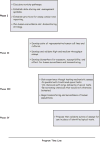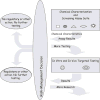Toxicity testing in the 21st century: a vision and a strategy
- PMID: 20574894
- PMCID: PMC4410863
- DOI: 10.1080/10937404.2010.483176
Toxicity testing in the 21st century: a vision and a strategy
Abstract
With the release of the landmark report Toxicity Testing in the 21st Century: A Vision and a Strategy, the U.S. National Academy of Sciences, in 2007, precipitated a major change in the way toxicity testing is conducted. It envisions increased efficiency in toxicity testing and decreased animal usage by transitioning from current expensive and lengthy in vivo testing with qualitative endpoints to in vitro toxicity pathway assays on human cells or cell lines using robotic high-throughput screening with mechanistic quantitative parameters. Risk assessment in the exposed human population would focus on avoiding significant perturbations in these toxicity pathways. Computational systems biology models would be implemented to determine the dose-response models of perturbations of pathway function. Extrapolation of in vitro results to in vivo human blood and tissue concentrations would be based on pharmacokinetic models for the given exposure condition. This practice would enhance human relevance of test results, and would cover several test agents, compared to traditional toxicological testing strategies. As all the tools that are necessary to implement the vision are currently available or in an advanced stage of development, the key prerequisites to achieving this paradigm shift are a commitment to change in the scientific community, which could be facilitated by a broad discussion of the vision, and obtaining necessary resources to enhance current knowledge of pathway perturbations and pathway assays in humans and to implement computational systems biology models. Implementation of these strategies would result in a new toxicity testing paradigm firmly based on human biology.
Figures












References
-
- Abdala-Valencia H, Earwood J, Bansal S, Jansen M, Babcock G, Garvy B, Wills-Karp M, Cook-Mills JM. Non-hematopoietic NADPH oxidase regulation of lung eosinophilia and airway hyperresponsiveness in experimentally-induced asthma. Am J Physiol Lung Cell Mol Physiol. 2007;292:L1111–L1125. - PMC - PubMed
-
- Affymetrix Corporation. Gene Chip Arrays. Affymetrix Corporation; 2007. Available at http://www.affymetrix.com/products/arrays/specific/hgu133plus.affx.
-
- Akpinar-Elci M, Kanwal R, Kreiss K. Bronchiolitis obliterans syndrome in popcorn plant workers. Am J Respir Crit Care Med. 2002;165:A526–A526.
-
- Akutsu T, Kuhara S, Maruyama O, Miyano S. A system for identifying genetic networks from gene expression patterns produced by gene disruption and overexpressions. Genome Inform Ser Workshop Genome Inform. 1998;9:151–160. - PubMed
-
- Aldridge BB, Burke JM, Lauffenburger DA, Sorger PK. Physicochemical modeling of cell signaling pathways. Nat Cell Biol. 2006;8:1195–1203. - PubMed
Publication types
MeSH terms
Substances
Grants and funding
LinkOut - more resources
Full Text Sources
Other Literature Sources
Research Materials
